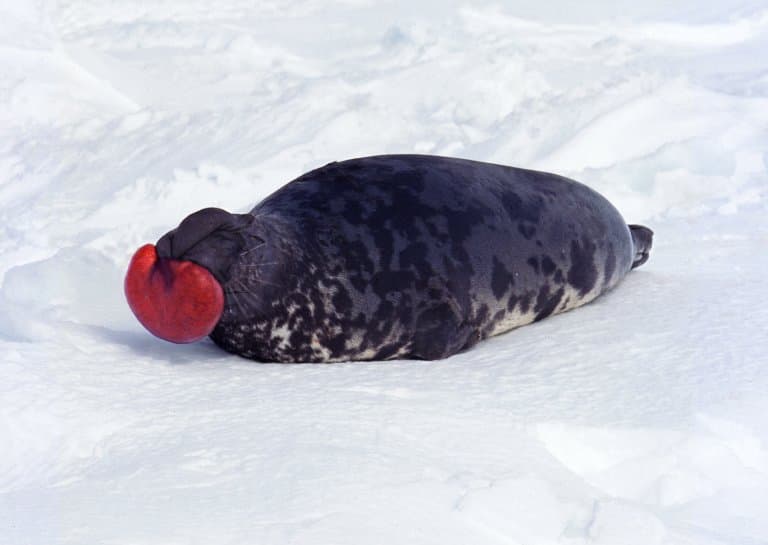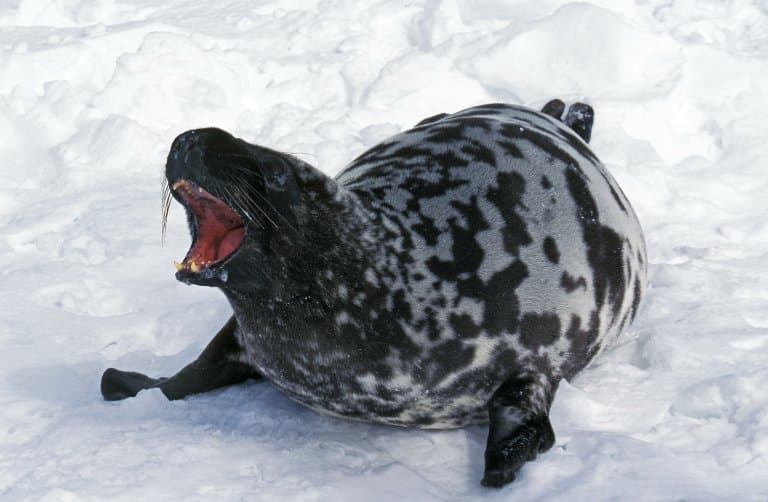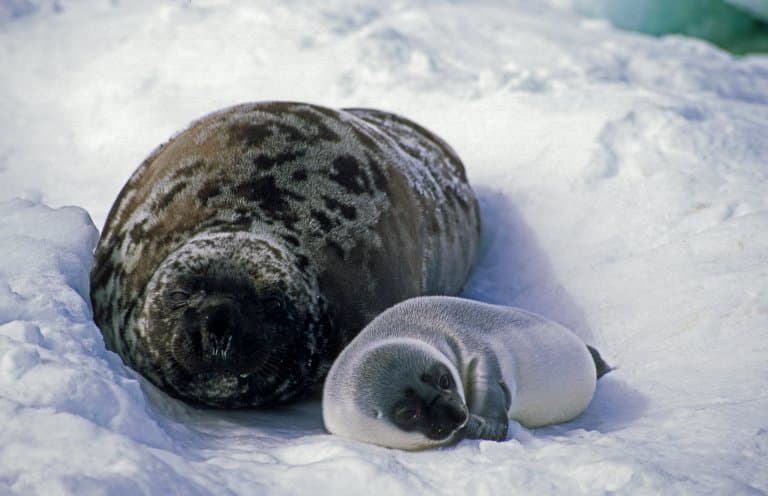Hooded Seal Profile
Elephant seals are well known for their enormous noses. They keep them on display year-round, flapping them about aggressively when troubled.
But there’s another member of this family whose bulbous nasal displays are kept under wraps; brought out only when needed. These are the hooded seals, and they’re just as weird and unusual, despite being better able to hide it.
Hooded seals are large phocids found in the North Atlantic and Arctic oceans, infamous for the males that have a strange expandable balloon-like sac that comes out of their nostril.

Hooded Seal Facts Overview
| Habitat: | Cold water marine |
| Location: | North Atlantic and Arctic Oceans |
| Lifespan: | Up to around 35 years |
| Size: | 2.6 – 3.5m (8.6 – 11.5ft) long |
| Weight: | Up to 410kg (900lb) |
| Color: | Blue-grey with black spots |
| Diet: | Squid, shellfish, crustaceans, fish |
| Predators: | Polar bears, sharks, orca |
| Top Speed: | Not recorded |
| No. of Species: |
1 |
| Conservation Status: |
Vulnerable |
Hooded seals are named after a startling mating and threat display. Their genus name ‘Cystophora’ in Greek means “bladder-bearer”, in reference to their inflatable organ.
They spend most of their lives migrating between pack ice floes, and are reliant on them for breeding. They are typically found in 4 districts with pack ice – Jan Mayen Island (northeast of Iceland), off Labrador and northeastern Newfoundland, the Gulf of St. Lawrence, and the Davis Strait (near to Greenland).
As a highly migratory animal, they can move long distances, and have been spotted as far as the Canary Islands, and even Guadeloupe.
The hooded seal is generally solitary, except during mating and molting seasons and are more aggressive and territorial than other seals.
They feed in the deep waters, and can handle conditions most would perish in. They have thick blubber to cope with the cold and can grow up to 3.5m and can weigh over 400kg (900lb).
Their diet is rich in fatty acids and they will eat crustaceans, krill, as well as fish, squid and mussels.
Pre 1940’s the hooded seal was hunted for oil and leather, and they are still today across Greenland, Canada, Russia, and Norway – mainly for subsistence, but also as bycatch.
While populations in the Atlantic are thought to have declined by up to 90% over the last 60 years, they are thought to be stable now. Due to global warming and the impact on their habitat, the IUCN currently classifies the hooded seal as vulnerable.
Interesting Hooded Seal Facts
1. They are remarkably well adapted to life on and under the Arctic ice
Hooded seals are covered in thick blubber, streamlined, furry bodies, and a particular sensitivity to UV light that allows increased contrast in the ice and better visibility in the dim blue light of the deep water.
When you shine a light into the bushes at night and spot two eyes peering back at you, you’re likely picking up the tapetum lucidium of a carnivore. This reflective membrane aids with night vision by bouncing more light back inside the eye to the retina.
In most mammals, this membrane has a pigment that gives it a colour; in hooded seals, it’s almost entirely blank. This suggests a high level of adaptation to deep diving vision, something which has been found in sperm whales and greys. 1

And this makes sense, because:
2. They’re Deep Divers
Within just a few days of being born, hooded seal pups are taking to the water. They’re capable of small dives almost immediately, and only get better with age.
An accomplished hooded seal can dive down more than 1km and stay under for an hour.
They achive this with incredible dive reflexes that slow down metabolism, channel blood into the high-priority organs like the brain, and a series of specialised proteins that allow them to stay alert with less oxygen than most mammals would be able to survive on. 2
3. They gain weight alarmingly fast
Growing up on the unstable pack ice of the Arctic brings two main problems: first, the ice can split and drown (or freeze) you at any minute. Second, polar bears!
Add to this that the ice is floating about at random and it’s clear why, after being born (or whelped), hooded seals need to get mobile, fast.
One peculiar and amazing strategy is to minimize the amount of time the pup needs to be nursed. Hooded seals do this to the extreme, with no loss of final juvenile bodyweight.
Pups can grow more than 20kg in the 3-5 days of nursing, commonly putting on over 7kg of mass in a 24h period; faster than similar mammals by up to ten times!
This is also the shortest lactation period of any mammal. As soon as weaning is complete, it’s thought the female goes straight back into the water to mate again. 3

4. This allows for variable mating strategies
Perhaps as another adaptation to such a dynamic environment, mating strategies can take full advantage of this fast seal pup turnover.
Some males are relatively sedentary, but with all the weaning females no more than 4 days from becoming receptive, even they get an easy shot at mating.
Others guard a handful of females, and others still perform “serial monogamy”, able to commit to a single female for the duration of the breeding period and move onto another one for the next round. Some males are nowhere to be found.
This unusual mix of mating strategies allows for one form or another to survive an unpredictable shift in environments and represents an interesting evolution of social behaviour in response to a chaotic habitat. 4
5. They molt
Pups are born with a slate blue-grey coat with whitish bellies, and are known as “blue-backs”.
Pups will first molt their coat after about 14 months. This thin non lanugo fur coat which is a less efficient thermoregulating, is replaced by a thicker coat.
Adult hooded seals will shed their fur and a layer of skin for a new coat each year typically around their mating period in July.
They do it all at once and it takes around 25 days, which is known as a ‘catastrophic molt’, rather than a gradual process like a domestic cat over months.
6. They grow into balloons
Hooded seals are very politely named.
The hood is actually a grotesque flap of expandable skin of the nasal septum, which, when inflated, sends a meaty snot bubble out of the nose and over the seal’s head.
Only males have ‘hoods’, and they’re used in two main ways.
This is clearly intimidating and very upsetting, so it’s not hard to imagine how the hood can be used as a threat display, but what’s a little more puzzling is that the females seem to love it.
This big, red, nose balloon escapes through what is the largest nostril in the true seal family. The larger the bubble, the sexier the seal. And the males seem to continuously increase the size of their skulls for over 20 years to accommodate the biggest nose balloon possible. 5
7. The bigger the inflatable nose, the better
Sexual selection can be a strange thing. Sometimes, seemingly-useless traits are favoured for no apparent reason.
In the violent world of mammals, competition is an expensive and dangerous necessity, and the typical solution to mammalian competition is to be larger than your peers.
Extra weight means you get to throw it around, but this is still resource-intensive (and can be lethal), and should be avoided where possible.
So, having a proxy for your fighting prowess is a useful way to reap the rewards of being enormous without actually having to get up and fight.
In hooded seals, a giant balloon suggests a giant male, and as a competitor, you don’t want to mess with him. This translates indirectly into fitness and mating potential, and the ability to guard a female against other males.
So, while in humans, a giant snot bubble suggests a poor-quality mate, it means something very different in hooded seals.
8. They’re in trouble
As you might have considered, living on floating sea ice is a bit of a handicap in a warming world, and the habitats for the hooded seal are shrinking.
The global population is considered vulnerable by the IUCN, but trends in population are unknown.
What is known is that some smaller populations are in decline, and models predict a 7% decline per year over the next decade. This is a species in dire need of better surveying, as population counts are sorely lacking in most areas.
They are currently deemed one of the most sensitive marine mammal species in the Arctic to the impacts of climate change due to their preference for pack-ice breeding locations. 6

Hooded Seal Fact-File Summary
Scientific Classification
| Kingdom: | Animalia |
| Phylum: | Chordata |
| Class: | Mammalia |
| Order: | Carnivora |
| Family: |
Phocidae |
| Genus: |
Cystophora |
| Species: |
Cystophora Cristata |
Fact Sources & References
- Chris Hogg et al (2015), “The eyes of the deep diving hooded seal (Cystophora cristata) enhance sensitivity to ultraviolet light”, Biol Open.
- Lars P. Folkow & Arnoldus Schytte Blix (1999), “Diving behaviour of hooded seals (Cystophora cristata) in the Greenland and Norwegian Seas”, SpringerLink.
- Agnete Pedersen Evertsen (2021), “The metabolism of lean and fat hooded seal pups (Cystophora cristata)”, Arctic University of Norway.
- Kit M. Kovacs (2011), “Mating strategies in the hooded seal (Cystophora cristata)“, Canadian Journal of Zoology.
- ØYSTEIN WIIG (1986), “Sexual shape dimorphism in the skull of the hooded seal“, Sci Hub.
- Kovacs, K.M (2016), “Cystophora cristata“, The IUCN Red List of Threatened Species.
